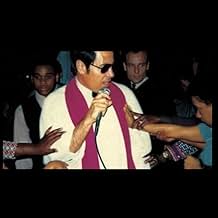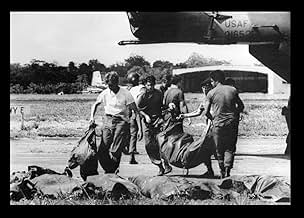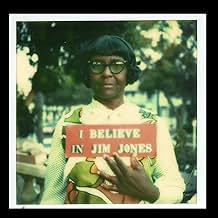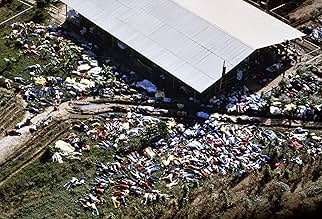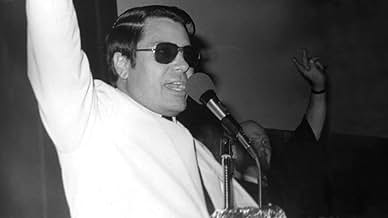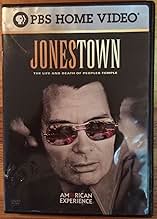Jonestown: The Life and Death of Peoples Temple
- 2006
- 1h 26min
Añade un argumento en tu idiomaFeaturing never-before-seen footage, this documentary delivers a startling new look at the Peoples Temple, headed by preacher Jim Jones who, in 1978, led more than 900 members to Guyana, whe... Leer todoFeaturing never-before-seen footage, this documentary delivers a startling new look at the Peoples Temple, headed by preacher Jim Jones who, in 1978, led more than 900 members to Guyana, where he orchestrated a mass suicide via tainted punch.Featuring never-before-seen footage, this documentary delivers a startling new look at the Peoples Temple, headed by preacher Jim Jones who, in 1978, led more than 900 members to Guyana, where he orchestrated a mass suicide via tainted punch.
- Dirección
- Guión
- Reparto principal
- Premios
- 1 premio y 4 nominaciones en total
- Self
- (as Rev. Garnett Day)
Reseñas destacadas
The whole People's Temple story always struck me as just another of the 60's cult phenomena. We had Rajneesh and his farm, and uncountable other guru's who exploited, and continue to exploit, large numbers of gullible followers. The Moonies are still with us, but well below the radar most of the time.
What's odd about Jim Jones -- to me, anyway -- is that no one really seems to know who this guy really was. This film gives more insight than anything else I've seen or read. It talks about his childhood, which was extremely poor, and his family situation, which was equally grim, so we get some insight there. But he was a very carefully guarded fellow. Always wearing those shades, always talking in the manner of a preacher. But who was he really? What was he like when he took off the robes and had a beer? We may never know. His followers certainly didn't know, and no doubt that's a major part of the problem. There is one scene in this documentary in which Jones is standing at the back of a group of people at a large gathering, and his demeanor reminded me of the dictator in North Korea -- it was that kind of vague, arrogant, totally in control look. Spooky.
The most telling comment in this film was the remark made by one of the PT's former members, who said "No one ever goes and joins a cult. They join a church, or a club." But what is the tipping point at which people can tolerate psychological and physical abuse against themselves and their friends? We don't get an answer to that. The people who made this film didn't have to tell us the answer, but it would have been a better film if they had.
As Jones staked out ever greater claims for himself, he placed himself on a trajectory of spiritual fraud that was so steep that any mis-step or retreat might bring his whole house of cards to the point of collapse. He therefore became hopelessly compromised: he could either become the messiah or another one of California's many prison inmates. The stress of this might explain the paranoia, the abuse of those in his power and the self-abuse that occurred as his 'ministry' progressed. In the end he had taken his loyal and long-suffering congregation so far (both emotionally and physically) that he must have reasoned that the only way of evading an wretched reckoning was by some form of abdication - which took the form of his own suicide and the murder of almost all of his followers. Jones was all of a piece with the likes of Charles Manson or David Koresh.
In view of his increasingly outré behaviour, it was almost inevitable that he should have gravitated towards San Francisco and that he should have become prominent in local politics under the aegis of the well-meaning (but arguably misguided) George Moscone. The film does not mention the close connections between the doomed Leo Ryan and Moscone, nor the imminent assassination of Moscone and Harvey Milk by Dan White. That was unfortunate, because it underscored the strangeness of this remarkable story. However, it is by no means a fatal omission. I would have appreciated some detail on the attitude of the Guyanese authorities to this strange Temple in the jungle. Did the government of Forbes Burnham and Arthur Chung know anything about it and the danger that cult members were in? Did they make any attempt to intervene?
I saw this film as part of the 2006 Times/BFI London Film Festival, and it is regrettable that it did not receive more publicity (not least in The Times itself). The story was told dead straight with little of the ostentatious editing that is now so common in documentaries, and is all the more effective for it. The audience left the theatre in something approaching a state of utter desolation - a tribute to the terrible nature of the story, the integrity of the witnesses and the ability of Stanley Nelson and his colleagues.
The film contains many scenes (footage of services in People's Temple) that seem joyous - and they are all the more tragic for that. Yet I could never quite tell what was in the eyes of all these doomed worshippers (many of whom were otherwise helpless, lonely and frail). Was it rapture or was it...terror?
Untrained in the ministry, he nonetheless started his own church in Indiana - an offshoot of the Christian Church (Disciples of Christ) - while still in his early 20s, later, in 1965, moving it west to a rural commune-like setting in Ukiah, in Northern California, when he was 34, where he also renamed the church People's Temple Full Gospel Church.
After 9 years, in 1974 he moved the church again, this time to San Francisco, where he ingratiated himself with local politicos like George Moscone and Willie Brown, and, in return for his support of Moscone for Mayor, Jones was appointed to the city's housing commission. By 1977 Jones had the itch to move again, and this time his church bought a large tract of land in the interior of Guyana, in northwestern South America. There a settlement, Jonestown, was rapidly established to permanently house over 1,000 church members. In November, 1978, after receiving complaints that all was not well in Jonestown, that people were being forcibly separated from loved ones back home and more or less held hostage, a California Congressman, Leo Ryan, made a trip to Jonestown to see for himself what was going on.
Ryan never returned, for he was shot and killed on the aircraft runway at Jonestown by armed stooges of Jones's, on orders to do so because Jones feared that Ryan would bring trouble if allowed to return to the States. Later that same day, November 18, 1978, Jones used his extensive PA system to order all of his supplicants to take a cyanide drink, to escape the misery that would befall Jonestown once authorities came in large numbers, to go on over to the other side, i.e., presumably to Heaven, where they would find peace.
911 church members died that day, many infants and children given poison by their parents, who then also took the poison drink to create possibly the largest mass suicide in history. Some who did not take poison were, like Rep. Ryan, shot to death. This was also the apparent cause of death for Jones himself. Another 80 members were away on some sort of field trip and were spared.
This is the fifth and perhaps most unusual of director Stanley Nelson's documentaries, which always concern race and the African-American condition (his prior feature films have taken up black press journalists; Marcus Garvey; Oaks Bluff, a black summer community on Martha's Vineyard; and the musical group Sweet Honey in the Rock).
Nelson's interest in Jonestown is connected with the fact that a majority of Jones's supplicants were black. Jones pandered to the suffering of poor blacks and whites alike. He also had sex with many women in the church, and even offered to sodomize anyone - female or male - who asked for or wanted this kind of connection to him, and apparently many did.
Nelson's approach here is intensely personal. He intercuts archival footage - of Jones's life, his activities and various stages in the development of his church - with contemporary interviews of persons who lost loved ones in Guyana. There are no talking heads: no sociologists, no academics who study religious cults, not a single mental health professional to educate us here. Nelson doesn't want us to understand the root causes of this tragedy; he wants us to feel the pain, the grief that this horrible and senseless loss of life wrought, just to feed the craving for power that was obviously Jones's main source of sustenance. It is an agonizing story to witness. My grades: 7/10, B (Seen on 11/25/06)
It's not clear if it will get distributed theatrically but, if not, the director said it will air on PBS in 2007. Highly recommended.
¿Sabías que...?
- CuriosidadesBased on the same real life events as Jonestown Cult Suicide (2012), Jonestown Massacre: As We Watched (2018), Jonestown: Terror in the Jungle (2018), Jonestown (2013), Jonestown: Paradise Lost (2007), Jonestown: The Women Behind the Massacre (2018), La tragedia de Guyana (1980), The Jonestown Haunting (2020), Jonestown: The Life and Death of the Peoples Temple (2007), The Jonestown Massacre (2016) and Truth and Lies: Jonestown, Paradise Lost (2018).
- Citas
Deborah Layton: [on Jim Jones's brainwashing of his followers at Jonestown] Every night at some point, his voice would come over the loudspeaker, and he'd say, "I'm sending somebody out tonight. Somebody you know. Somebody you trust. And they're gonna act like they wanna leave. But this is a loyalty test, and you need to turn them in."
- Banda sonoraWelcome
Performed by the People's Temple Choir
Selecciones populares
- How long is Jonestown: The Life and Death of Peoples Temple?Con tecnología de Alexa
Detalles
- Fecha de lanzamiento
- País de origen
- Sitio oficial
- Idioma
- Títulos en diferentes países
- Jonestown - Från början till slutet
- Empresa productora
- Ver más compañías en los créditos en IMDbPro
Taquilla
- Recaudación en Estados Unidos y Canadá
- 148.292 US$
- Fin de semana de estreno en EE. UU. y Canadá
- 7482 US$
- 22 oct 2006
- Recaudación en todo el mundo
- 148.292 US$
Contribuir a esta página





